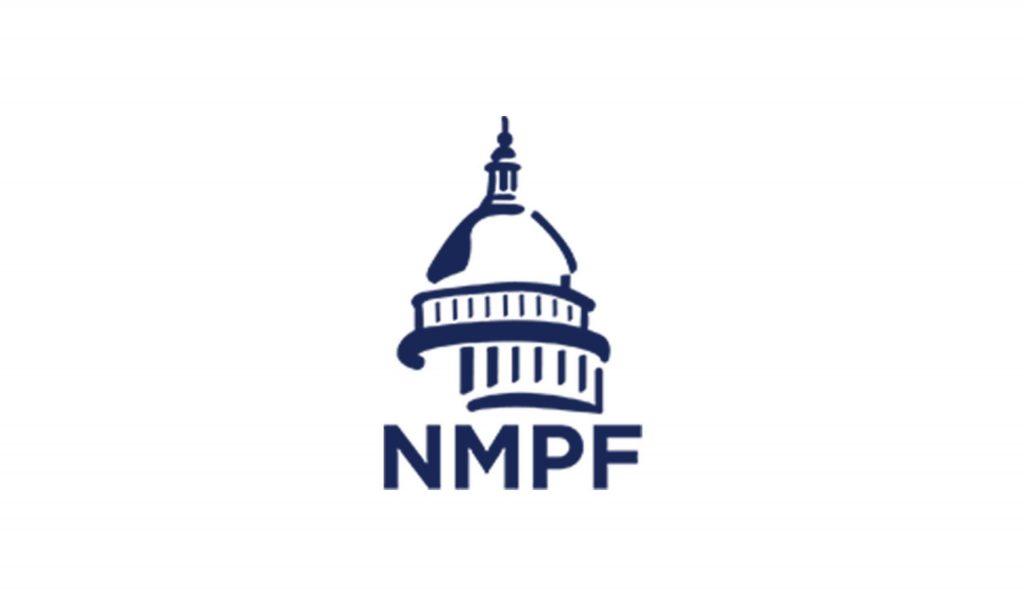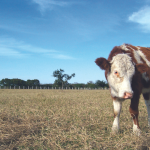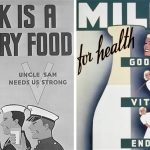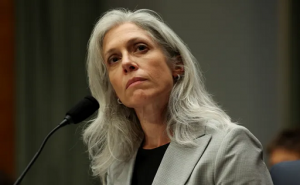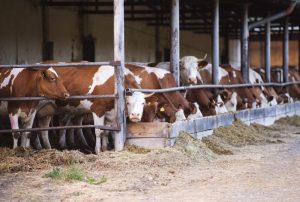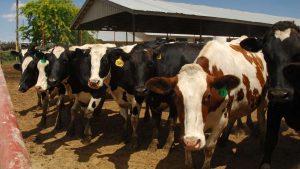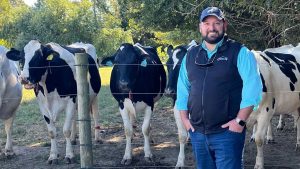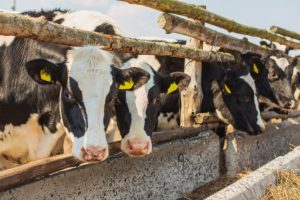
Biosecurity – what it is, and how to achieve it – is at the top of every dairy farmer’s mind as cases of Highly Pathogenic Avian Influenza (HPAI) have been found in dairy cattle in several states. Every farmer can take simple, but meaningful, steps to ensure a well-protected industry, said Karen Jordan, a Doctor of Veterinary Medicine, chairwoman of the National Dairy FARM Program’s animal care task force, and a member of NMPF’s Board of Directors, in a Dairy Defined Podcast released today.
“When you start trying to protect against organisms that you can’t see, that puts you in a whole different ballpark,” said Jordan, who also raises about 200 dairy cattle in Siler City, NC. “The bright side is, we’ve got a disease that we don’t have dead animals. We do have an economic disruption, severely. But this gives us an opportunity to really take a hard look at our farms and see what that biosecurity really needs to look like and then how we really enhance it.”
Jordan is joined in the podcast by NMPF’s Chief Science Officer, Jamie Jonker, who is leading NMPF’s HPAI response. The Dairy Defined podcast, you can find and subscribe to the podcast on Apple Podcasts, Spotify, Google Podcasts and Amazon Music under the podcast name “Dairy Defined.”
Media outlets may use clips from the podcast on the condition of attribution to the National Milk Producers Federation.
TRANSCRIPT
Alan Bjerga: Hello, and welcome to the Dairy Defined Podcast.
Cases of highly pathogenic avian influenza found in dairy cattle in several states are placing biosecurity at the top of every dairy farmer’s mind. Fortunately, today we’re joined by one of dairy’s leading experts on biosecurity, dairy farmer and veterinarian Karen Jordan, doctor of veterinary medicine. She’s the chairwoman of the National Dairy FARM Programs, FARM stands for Farmers Assuring Responsible Management, Farms Animal Care Task Force. She’s also a member of NMPF’s Board of Directors.
She raises about 200 dairy cattle in Siler City, North Carolina. Also interjecting on this podcast as necessary is NMPF’s Chief Science Officer, Dr. Jamie Jonker, who is the lead staffer on FARM’s Biosecurity component. Thanks for joining us.
Karen Jordan, DVM: Well, thank you, Alan. I’m glad we’re doing this. I think it’s really a timely topic to maybe we can help shed a little bit of light on some possibilities for how dairy farmers could look at biosecurity and what it could look like on their dairies currently with what we’re having to deal with.
Alan Bjerga: So let’s start, Karen, by talking a little bit about the importance of biosecurity in dairy farms. And even before that, what does biosecurity even mean?
Karen Jordan, DVM: When I think of biosecurity, I think I’ve got to protect my animals against something that I cannot see. Whereas security, I tell people we have a gated community for our cows. So every day we’ve got our gates and just protecting against general security. But when you start trying to protect against organisms that you can’t see, that puts you in a whole different ballpark. And for us on our farm, the first thing we’re starting with is trying to create that culture of our employees and actually of our neighbors too, because it’s quite the training process to train your neighbors and all the folks, salesmen, supply people. You’ve got to train them to what the behaviors that you expect now. We can get to some interesting conversations with people, but usually they come around and go, “Okay, I understand. I understand now why you’re taking all these precautions.”
Alan Bjerga: Biosecurity would seem to require looking at a farm with a completely different set of eyes.
Karen Jordan, DVM: It does. It does. And all the procedures that we put in place, to me, you’ve got to look at the organism that is the hot topic of the day. And of course we know what we’ve got right now is the famous bird flu, and you’ve got to have biosecurity that makes sense for that organism. And also that makes sense for how we’re trying to continue to keep milk on the shelves for people, and how we’re trying to protect the welfare of our animals. So everything is, you’ve just got have a really big picture and what makes sense for your farm.
Alan Bjerga: Well, and it requires a lot of different practices too. I know you’ve spoken in the past about how when HPAI and dairy cattle started becoming a rising concern, one of the things you did was chop down trees. Why did you do that and how does that illustrate some of the challenges a farm faces in a situation like this?
Karen Jordan, DVM: Yeah, so it got recorded as chopping down trees. It was not beautiful trees. It’s actually scrubby stuff, like one inch, three inch things that had been on the list to do some landscaping forever. But now we’re really motivated. And the reason being for our birds that show up, they’ll go to the trough and then if you scare them away, then they go to those scrubby bushes and hide out until there’s no activity at the trough, and then they come back. Ours don’t really. I mean, you might see a bird occasionally in the freestyle barn, but most of the time ours seem to be pretty smart and they just hang out at the feed trough. So I’m trying to remove that comfort area for those birds, those bushy, ugly, ugly, ugly scrubby trees. So that has been what we have really concentrated on first.
Alan Bjerga: What are some other things you’re doing?
Karen Jordan, DVM: So the other things we did, shut the gates at the farm. Just like when our bull stud guy came the other day, he just barely backed off the asphalt, we came to him with our tanks. Just like when our health inspector comes, and then she’ll have to disinfect her boots and walk on in to do her health inspection. So anybody that’s not necessary, I mean really necessary to get past those gates, they’re having to stop right off, just pull off the paved road.
And then as far as my milk truck driver, I’ve supplied booties for him to swing his legs over off of his platform, put the booties on, wear the booties while he’s having to go from his truck to the tank and then take the booties off after he takes a couple of steps up, then he takes the booties off. And he just throws them on the ground, which that whole process right there could be nicer, but right this second, that’s about all I’ve got to work with trying to take care of my milk truck driver. The other thing I’ve asked him is, “Please do not spill any milk. And if you do, we’re going to have to disinfect wherever that milk landed.”
Alan Bjerga: It’s important to note, and I want to bring Dr. Jonker into this conversation. Biosecurity isn’t new to dairy. HPAI is, but this is something that dairy farmers have been thinking about for a while. Jamie, from a National Dairy Farm program standpoint, what do we already know about procedures that can be applied to the situation and what are we learning as dairy farmers go through this?
Jamie Jonker, PhD: Thanks, Alan. And yes, biosecurity really has been part of what dairy farmers have been doing for generations. They just probably didn’t call it biosecurity. So when we look at things like in the National Dairy Farm programs animal care area, we have a herd health plan requirement standard, for example. And that’s about things that you do to first help present, prevent disease from happening on a dairy farm. And when you think about biosecurity, as Karen was talking about how you can’t see these, you’re putting in place standards, protocols and procedures that help against these invisible things that you can’t see. We go back to germ theory from Louis Pasteur, and really biosecurity is about addressing those issues.
Back in 2021, we received a cooperative agreement from the USDA NADPRP program to actually build out a very specific part of the National Dairy Farm program on biosecurity. That program on biosecurity has two parts. The first is on everyday biosecurity, things that you do on an everyday basis to help reduce the risk of the introduction of pathogens and disease causing organisms onto your farm.
Then we have enhanced farm biosecurity that is an implementation of the Secure Milk Supply Program on the Dairy Farm. The Secure Milk Supply program was really designed for a foot and mouth disease outbreak. But I think that there are things in that enhanced biosecurity part of the National Dairy Farm program that apply here. Karen talked about limiting people and vehicles on the farm to only those that are specifically required at this point in time. Things like having disposable boots for people to come onto the farm, potential for sanitizing boots that people are wearing is another. And so there are a variety of things that we do know that would be helpful in a foot and mouth disease outbreak that can apply here as well. And Karen is just an example of how each dairy farm is looking at their own biosecurity today and making changes based upon the risk that they feel for about a high path AI coming to their dairy farm.
Alan Bjerga: Karen, you’re dairying in North Carolina, which has not been spared. What are you hearing from farmers and what do you tell them when they come to you for advice?
Karen Jordan, DVM: For this time right now, to me, you’ve got to take extreme caution if you’re going to actually bring new animals onto your facility. You better practice quarantine. Somehow you’ve got to figure that out.
Alan Bjerga: And what about the farm workers?
Karen Jordan, DVM: So the farm workers for our farm and then well for anybody’s, you’ve got to have come in with brand spanking clean clothes that day. Each day has got to be a new clean set of clothing. And then footwear that’s dedicated just for that farm. To me, a lot of times we’re on our feet so much, and some folks, certain boots is all they’re going to wear, and some of our boots can get really expensive. So just trying to have one pair for one farm. Especially some of our workers are going to have multiple farm jobs, so trying to get that point across to just have a dedicated footwear.
Jamie Jonker, PhD: And I might add, just building on what Karen has talked about for farm workers, particularly those farm workers that are milking or otherwise might be coming in contact with milk to add additional worker protection there. Our farm workers in the milking parlors already should be wearing glasses or goggles to help protect their eyes from errant hails, making sure that they don’t potentially splash teat dip in their eyes accidentally.
But this is also helpful for helping to keep errant milk from getting into their eyes. The one reported case of a farm worker having high path AI on a dairy farm had conjunctivitis, so inflammation in the eye. And so that would suggest that perhaps they got milk in their eye accidentally. And you could think about a farm worker that’s in the parlor, getting milk on their hands and accidentally rubbing their eye while there’s milk drops on their hands. And so things that we can do, particularly in the parlor where farm workers may have a greater exposure if there are sick cows, and particularly for those that are milking the sick animals who are separated from the rest of the herd and their milk doesn’t go into the commercial supply, but they may have an increased risk. And so making sure that we have the additional PPE for them, particularly in the protection of the eyes is important.
Alan Bjerga: Karen, Jamie, this obviously isn’t a situation that anyone wants that dairy is currently facing, but here we are. In a situation like this, it’s always a challenge to look for any sort of bright side, but is there anything you’ve seen so far in response to this situation that makes you feel like dairy is not only going to get through this but be positioned more strongly in the future as a result of it?
Karen Jordan, DVM: Well, I think just the first thing is really taking another look at your biosecurity is something that we don’t, as an industry, don’t spend a lot of time thinking about. And I think the bright side is, we’ve got a disease that we don’t have dead animals. We do have an economic disruption, severely. But this gives us an opportunity to really take a hard look at our farms and see what that biosecurity really needs to look like and then how we really enhance it should we get a high death type disease.
The other thing that I’ve seen, that I’ve been really encouraged with how this has come about is all the communication between many of our federal agencies and how we’ve all worked together between National Milk and our federal agencies for real good communication on the topic. And then also with the American Association of Bovine Practitioners, that group hit the ground running, trying to pull in the veterinary community in that affected area, plus other key veterinarians across the nation to try to have really good conversation and see where, as the veterinary community serve in the dairy industry that we needed to go to be of help to the industry.
Jamie Jonker, PhD: And I just want to emphasize a couple of things that Karen said there. I think the response from our state and federal animal health officials, our food safety officials at the Food and Drug Administration, the US Centers for Disease Control and Prevention on the farm worker side have been amazing. The role of our private veterinarians that are working with these affected herds in helping to first figure out what was happening. And then once we had better information and found out that it was a high path AI in dairy cattle, sharing that information so that we could own in on other herds that were having similar situations and identify that this was an issue in their herds as well. It’s really been an all hands on situation, and particularly for those farms that have been affected by having HPAI in their dairy cattle, they certainly have been severely impacted.
Karen mentioned the economics aspects to it, but also just the resources from the labor that they’ve had to put into their farms, helping to separate out the cows that have the clinical symptoms and getting those cows back into health has been a very difficult situation for them. And all of those farms that have been affected have been doing a fantastic job of doing the right thing for their cows and the right things for public safety by keeping that milk out of the commercial system. And so it’s really been an all hands on deck. We’re learning a lot of things as this goes on, and again, just reemphasizing. It’s really, really helping, I think the dairy sector look at what should the biosecurity on our farms look like in the 21st century.
Alan Bjerga: We’ve been speaking with Karen Jordan. She’s a doctor of veterinary medicine and chairwoman of the National Dairy Farm Program’s Animal Care Task force, as well as a North Carolina dairy farmer. She’s joined by an NMPF Chief Science Officer, Jamie Jonker. Karen, Jamie, thanks for joining us.
Karen Jordan, DVM: Thank you, Alan. I’m glad we did this.
Jamie Jonker, PhD: Thank you, Alan.
Alan Bjerga: NMPF has a special page devoted to resources on HPAI in dairy cattle. Just go to our homepage Nmpf.org and click on the red bar up top. You’ll see lots of resources and information on biosecurity, including a link to the Farm Program’s biosecurity page. The Dairy Defined Podcast can be found and subscribed to on Apple Podcasts, Spotify, Google Podcasts, and Amazon Music under the podcast name Dairy Defined. Thank you for joining us.
You can now read the most important #news on #eDairyNews #Whatsapp channels!!!
🇺🇸 eDairy News INGLÊS: https://whatsapp.com/channel/0029VaKsjzGDTkJyIN6hcP1K
